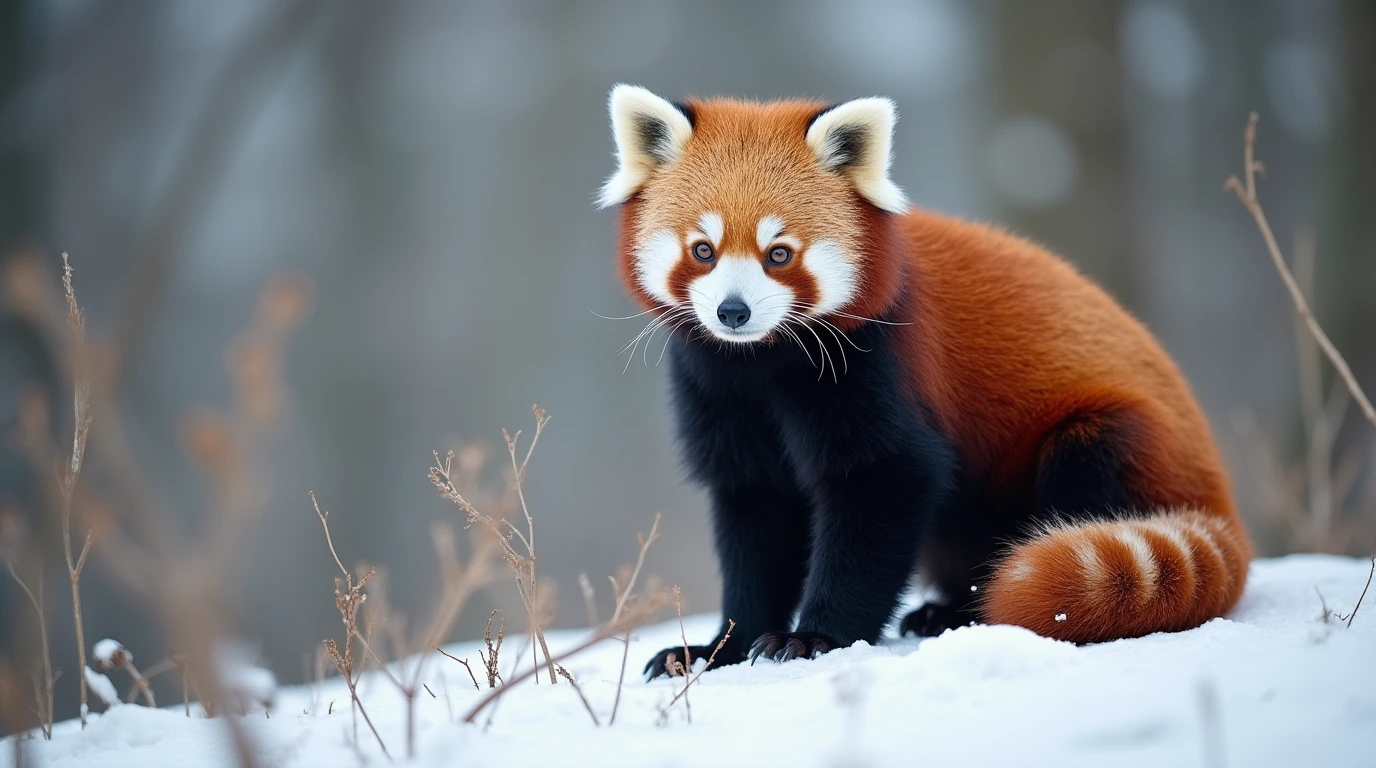Red pandas live in high-altitude forests where temperatures vary dramatically between seasons, ranging from -4°F (-20°C) in winter to warm summers that pose a risk of heat stress. To survive these extreme conditions, red pandas have developed specialized thermoregulation strategies, allowing them to stay warm in the cold and cool down in the heat. Their ability to adjust metabolism, modify behaviors, and use environmental resources helps them maintain a stable body temperature year-round
In winter, red pandas rely on their thick, double-layered fur to trap heat and protect them from freezing winds. They also exhibit heat-conserving behaviors, such as curling into a tight ball and wrapping their bushy tails around their bodies to retain warmth. Additionally, they lower their metabolic rate to conserve energy when food is scarce
During summer, red pandas are highly susceptible to heat stress and use various cooling strategies to prevent overheating. They pant to release excess heat, seek shaded areas, and stretch out on tree branches to increase airflow. Since they cannot sweat like humans, they lose most of their heat through their face and extremities, making shade and rest essential for survival in hot conditions
In this article, we will explore how red pandas regulate body temperature throughout the year, covering their cold-weather survival tactics, heat dissipation methods, metabolic adaptations, and the effects of climate change on thermoregulation
How Red Pandas Regulate Body Temperature in Changing Seasons

Red pandas are specially adapted to handle the extreme temperature variations of their high-altitude forest habitats. Their ability to regulate body temperature throughout the year is essential for survival, allowing them to conserve energy in freezing winters and prevent overheating in hot summers. They achieve this through a combination of fur insulation, behavioral modifications, and physiological adjustments
The Role of Thick Fur in Temperature Regulation
One of the most crucial adaptations for red pandas is their thick, double-layered fur, which acts as a natural insulator. The undercoat is soft and woolly, trapping body heat close to the skin, while the outer layer consists of longer, coarse guard hairs that provide protection against wind and moisture. This dual-layer system ensures that red pandas stay warm even when temperatures drop to -4°F (-20°C) in winter
Unlike some cold-weather animals that grow a thicker coat in winter and shed it in summer, red pandas maintain their dense fur year-round. During the hotter months, their fur does not significantly thin out, but it serves a different function: rather than keeping them warm, it helps reflect sunlight and prevents direct exposure to intense heat. However, this also makes red pandas prone to heat stress, requiring them to use behavioral cooling strategies in warm weather
Another unique feature of red pandas is that their fur covers not just their bodies, but also their feet, ears, and even the soles of their paws. This adaptation provides extra warmth in winter, preventing heat loss when they walk on snow-covered surfaces. In contrast, during summer, their fur-covered extremities make heat dissipation more difficult, requiring them to cool off through other means
Behavioral Adaptations for Staying Warm in Winter
In addition to their fur insulation, red pandas use specific behaviors to retain heat during the cold months:
Curling into a ball: One of their most common behaviors in winter is curling up tightly and wrapping their bushy tails around their bodies to trap heat. This posture helps them minimize exposed skin and reduces heat loss
Using natural shelters: Red pandas seek out tree hollows, rocky crevices, and dense bamboo thickets for additional insulation against harsh winds and snow. These microhabitats help protect them from direct exposure to freezing air
Basking in sunlight: On bright winter days, red pandas rest on sunlit branches, absorbing natural warmth to supplement their body heat
Reducing movement: To conserve energy, red pandas are less active in the coldest parts of the day, minimizing unnecessary activity that would require extra heat production
By combining fur insulation with behavioral adaptations, red pandas successfully withstand freezing temperatures without needing to hibernate or migrate to warmer regions
Cooling Strategies Red Pandas Use in Hot Weather
Red pandas are adapted for cold climates, meaning they struggle with excessive heat. When temperatures rise, they use a variety of strategies to prevent overheating:
Panting: Since red pandas cannot sweat, they use panting to release excess heat. This process allows moisture to evaporate from their tongue and mouth, cooling their body temperature
Seeking shade: Red pandas rest in shaded tree canopies or inside hollow logs to avoid direct sunlight, lowering the risk of heat stress
Stretching out: Instead of curling up, red pandas lie flat on tree branches, allowing air to circulate around their bodies to promote cooling
Being active at dawn and dusk: Red pandas are crepuscular, meaning they are most active in the cooler parts of the day—early morning and late evening—to avoid the peak heat of midday
Because their thick fur makes heat dissipation difficult, red pandas are highly vulnerable to high temperatures. Research from RedPandazine indicates that red pandas lose most of their body heat through their face and extremities, making their cooling behaviors essential for survival in warm conditions. For more insights into how red pandas regulate body temperature in different seasons, you can explore research from the Red Panda Network
Metabolic and Environmental Factors in Thermoregulation

In addition to fur insulation and behavioral adaptations, red pandas regulate their body temperature through metabolic adjustments and habitat selection. These factors help them conserve energy in winter and avoid overheating in summer, ensuring they remain functional year-round despite extreme climate variations
How Seasonal Metabolism Changes Help Red Pandas Survive
Red pandas are non-hibernating mammals, meaning they remain active year-round. However, they can adjust their metabolic rate depending on seasonal conditions to conserve energy and regulate body temperature:
Winter Metabolism: During cold months, red pandas enter a torpor-like state, where they lower their metabolic rate to conserve energy. This process is crucial when food (primarily bamboo) becomes less nutritious and harder to digest. By slowing their metabolism, red pandas reduce their caloric needs while still maintaining essential functions
Summer Metabolism: In contrast, during warm months, red pandas maintain a higher metabolic rate but adjust their activity levels to avoid heat stress. They rest more during the hottest parts of the day and are active in cooler periods, ensuring they do not overheat while foraging or climbing
Unlike true hibernators, such as bears, red pandas do not experience a long-term metabolic shutdown, but their ability to adjust energy use and heat production is key to their survival in an environment with extreme seasonal changes
The Impact of Habitat Selection on Temperature Regulation
Red pandas use their environment strategically to maintain a stable body temperature throughout the year:
Winter Shelter: During the colder months, red pandas seek out tree hollows, rocky crevices, and dense foliage to shield themselves from freezing winds and snowfall. These microhabitats act as natural insulators, reducing heat loss while they rest
Summer Cooling Zones: In warmer months, red pandas choose higher elevations and thick, shaded canopies to escape direct sunlight. They also gravitate toward forested areas with good airflow, helping them dissipate heat more effectively
Bamboo Forest Advantage: Since red pandas rely almost entirely on bamboo for food, their choice of habitat naturally aligns with their thermoregulation needs. Bamboo forests provide cooler microclimates in summer while offering protection from the elements in winter, making them ideal for year-round survival
By selecting the right environments for seasonal shelter and temperature control, red pandas reduce the energy needed to regulate body heat, increasing their chances of survival in extreme conditions
The Function of the Tail in Heat Retention and Cooling
The bushy tail of a red panda is one of its most important tools for thermoregulation, serving different purposes in summer and winter:
Winter Use: In cold weather, red pandas wrap their tails around their bodies, covering their face, paws, and exposed skin to conserve heat. This behavior is especially critical when they are sleeping, as it helps them retain body warmth overnight
Summer Use: While not used for warmth in hot conditions, the tail still plays a role in balance and movement, preventing red pandas from overexerting themselves while navigating tree branches. Since overheating is a major concern, limiting excess energy expenditure helps them avoid dangerous heat buildup
For more information on how red pandas use their metabolism and environment for temperature regulation, you can explore research from the Smithsonian’s National Zoo
Challenges to Red Panda Thermoregulation and Conservation

As climate patterns shift and human activity continues to impact natural ecosystems, red pandas face increasing challenges in regulating their body temperature. Rising global temperatures, habitat fragmentation, and changing food availability threaten their ability to maintain thermal balance year-round. Conservation efforts play a critical role in ensuring that red pandas can continue to adapt to environmental changes
How Captive Red Pandas Adapt to Temperature Changes
In zoos and wildlife sanctuaries, red pandas live in controlled environments, where temperature fluctuations are managed to support their natural behaviors. However, captive red pandas still exhibit instinctive thermoregulation strategies, similar to their wild counterparts:
Temperature-Controlled Enclosures: Many zoos provide heated dens during winter and cooling systems such as misting stations in summer to mimic their natural habitat
Shaded and Elevated Resting Areas: Since red pandas naturally seek cool, elevated resting spots, their enclosures are designed with trees, shaded platforms, and climbing structures that allow them to regulate body heat effectively
Diet Adjustments: Zoos modify nutritional intake seasonally, ensuring that red pandas receive extra food in winter to compensate for increased metabolic demands and hydrating food sources in summer to reduce dehydration risks
Despite these interventions, captive red pandas still experience heat stress in unusually warm conditions, reinforcing the need for climate adaptation measures in conservation programs
Climate Change and Its Effects on Red Panda Thermoregulation
Climate change poses one of the biggest threats to red pandas’ ability to regulate their body temperature. As temperatures rise, their cold-adapted physiology becomes a liability rather than an advantage, leading to increased risks of heat exhaustion, food shortages, and habitat loss:
Rising Temperatures: Red pandas struggle to cope with heat, as their thick fur and limited sweating ability make it difficult to cool down. Prolonged high temperatures can cause severe heat stress, increasing mortality rates in wild populations
Shrinking Bamboo Forests: Since bamboo is highly sensitive to temperature and rainfall, warming climates may lead to bamboo die-offs or seasonal shortages, forcing red pandas to expend more energy searching for food
Habitat Fragmentation: Deforestation and rising temperatures are pushing bamboo forests higher into the mountains, reducing the amount of available habitat and forcing red pandas to compete for limited space and resources
Scientists warn that without intervention, red pandas may struggle to adapt fast enough to climate changes, making conservation efforts critical in protecting their thermoregulation strategies
Conservation Strategies to Protect Red Pandas from Heat Stress
To mitigate the impact of climate change on red pandas, conservationists are implementing several protective measures to help them cope with rising temperatures and habitat challenges:
Reforestation Projects: Planting and preserving high-altitude bamboo forests ensures that red pandas continue to have cool, shaded environments to regulate body temperature
Wildlife Corridors: Creating connected forest pathways allows red pandas to move to cooler, higher-altitude regions if their habitats become too warm
Climate-Resilient Habitats: Conservation groups are working to protect bamboo ecosystems that are resistant to temperature fluctuations, ensuring long-term food security for red pandas
Public Awareness Campaigns: Educating local communities about habitat conservation and responsible tourism helps reduce human impact on red panda environments, supporting natural thermoregulation behaviors
By focusing on habitat protection, climate adaptation, and sustainable conservation strategies, conservationists are working to ensure that red pandas can continue regulating their body temperature naturally, even as global temperatures rise. For further details on conservation efforts, you can explore research from RedPandazine













